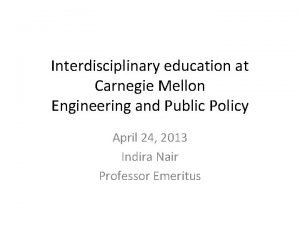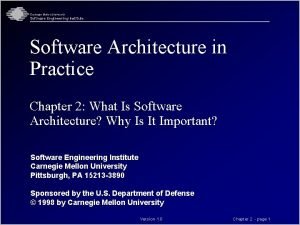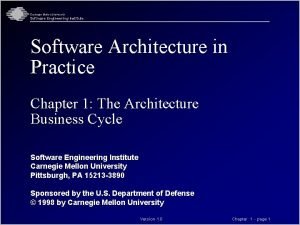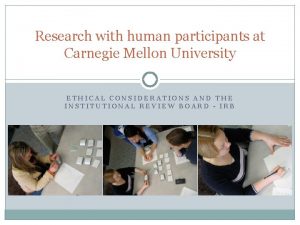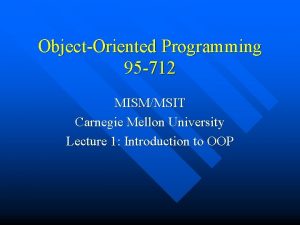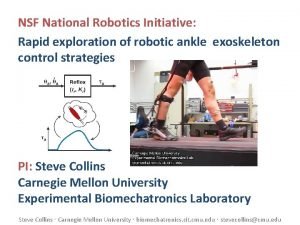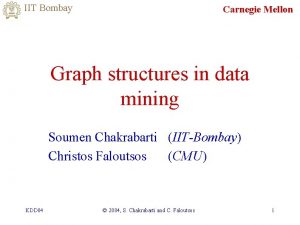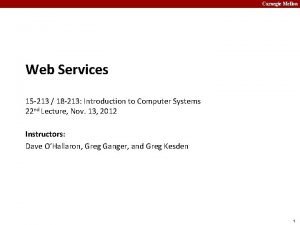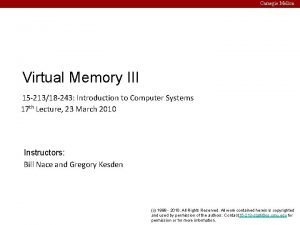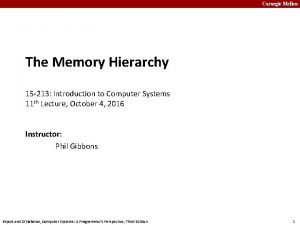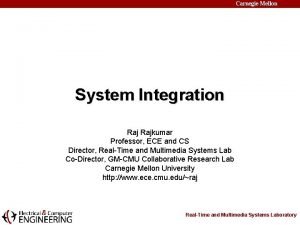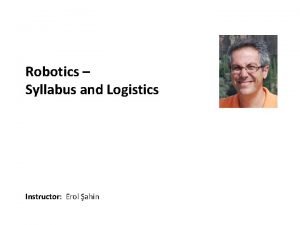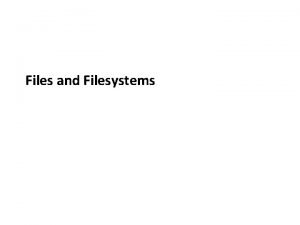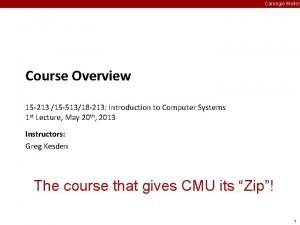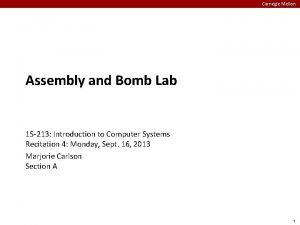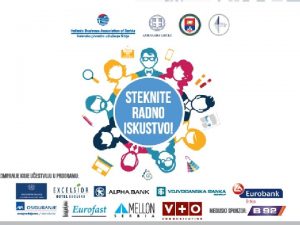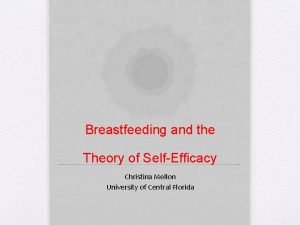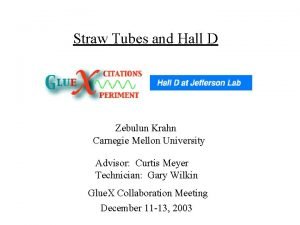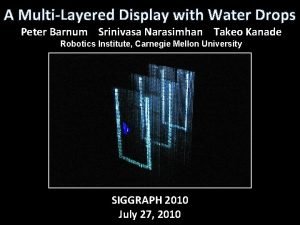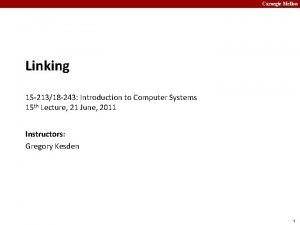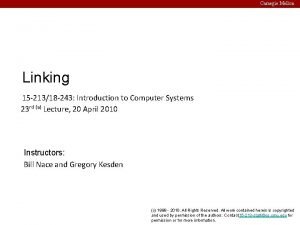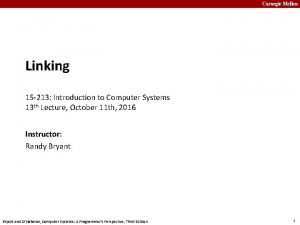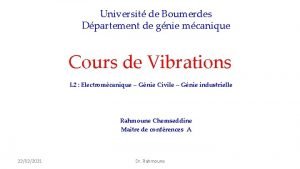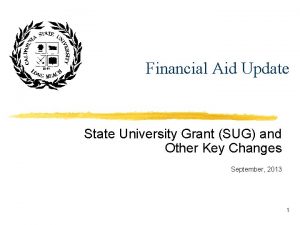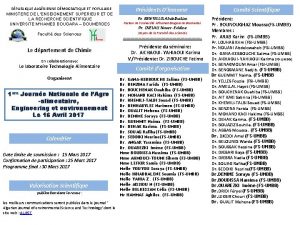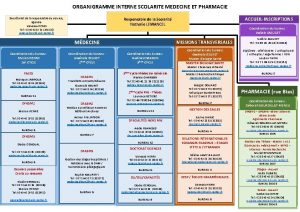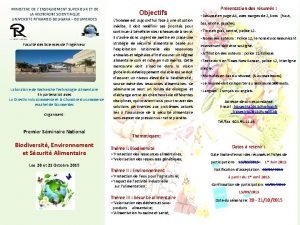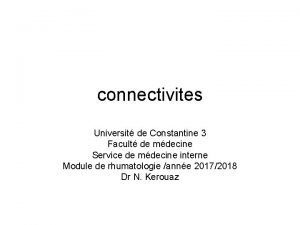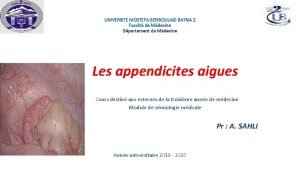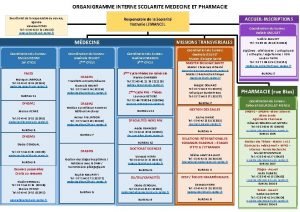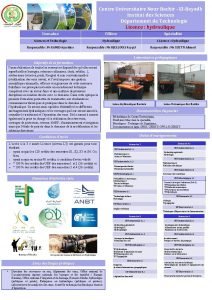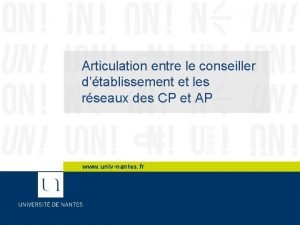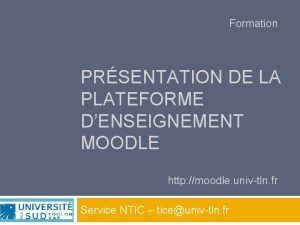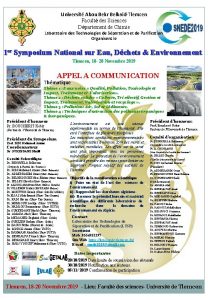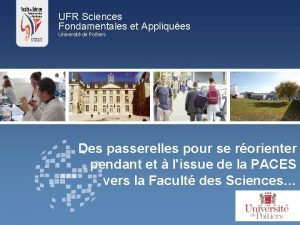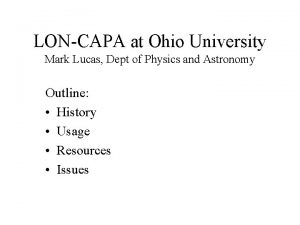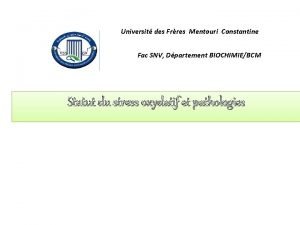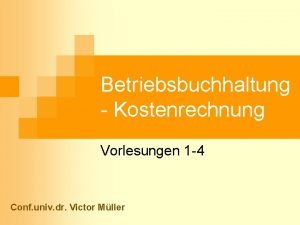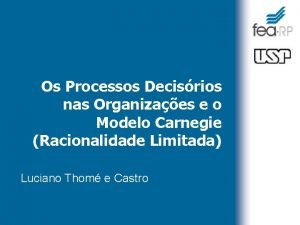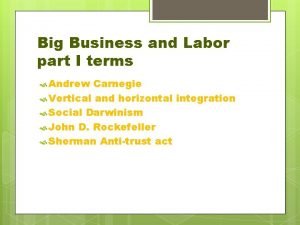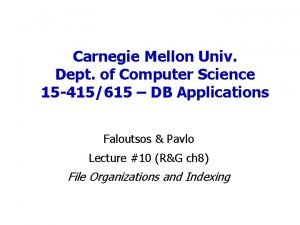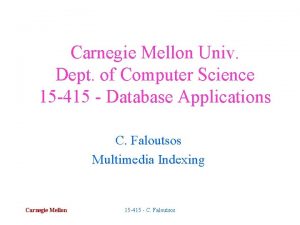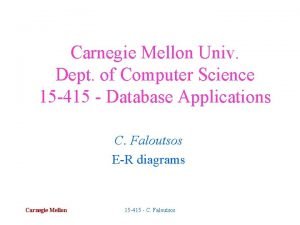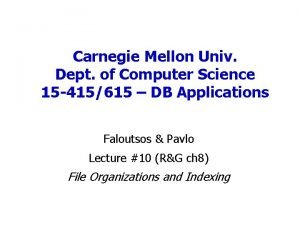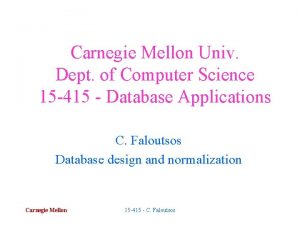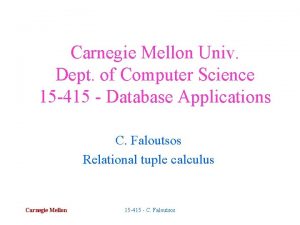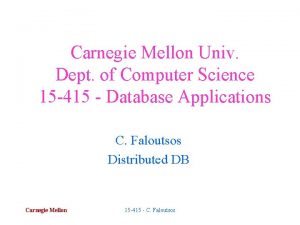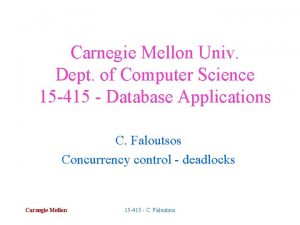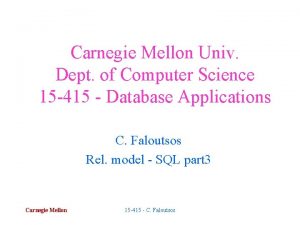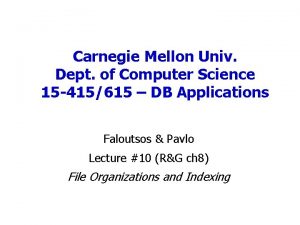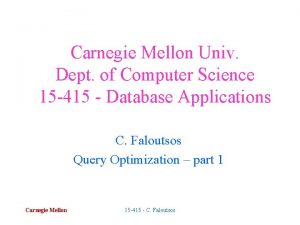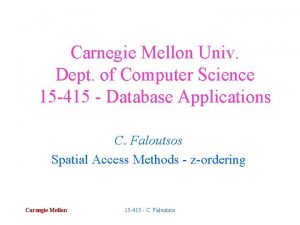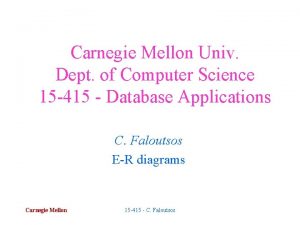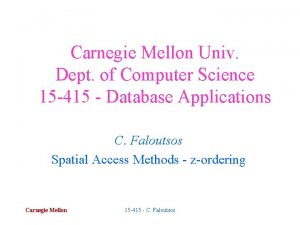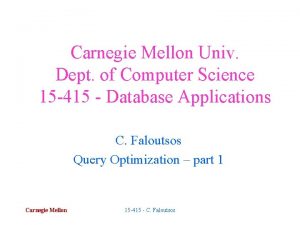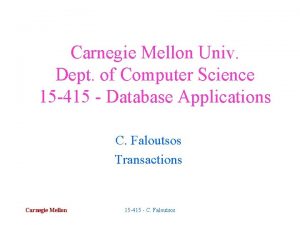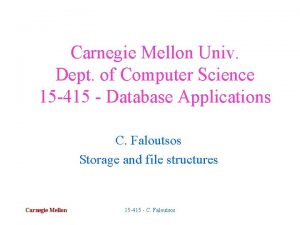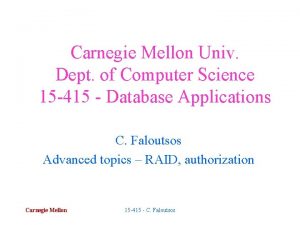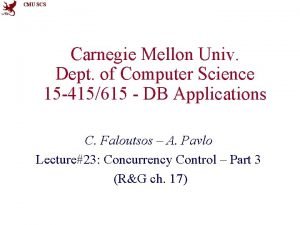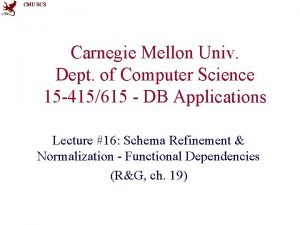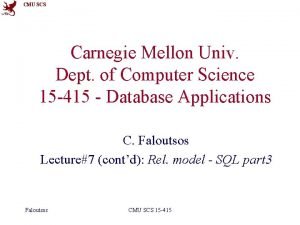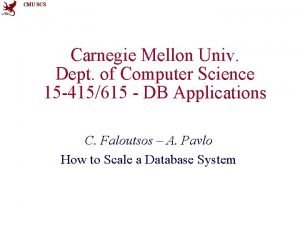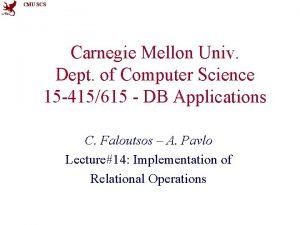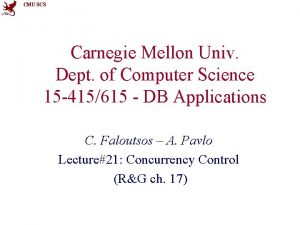Carnegie Mellon Univ Dept of Computer Science 15




























































- Slides: 60

Carnegie Mellon Univ. Dept. of Computer Science 15 -415 - Database Applications C. Faloutsos Relational model Carnegie Mellon 15 -415 - C. Faloutsos

Overview • history • concepts • Formal query languages – relational algebra – rel. tuple calculus – rel. domain calculus Carnegie Mellon 15 -415 - C. Faloutsos 2

History • • • before: records, pointers, sets etc introduced by E. F. Codd in 1970 revolutionary! first systems: 1977 -8 (System R; Ingres) Turing award in 1981 Carnegie Mellon 15 -415 - C. Faloutsos 3

Concepts • • Database: a set of relations (= tables) rows: tuples columns: attributes (or keys) superkey, candidate key, primary key Carnegie Mellon 15 -415 - C. Faloutsos 4

Example Database: Carnegie Mellon 15 -415 - C. Faloutsos 5

Example: cont’d Database: k-th attribute (Dk domain) rel. schema (attr+domains) tuple Carnegie Mellon 15 -415 - C. Faloutsos 6

Example: cont’d rel. schema (attr+domains) instance Carnegie Mellon 15 -415 - C. Faloutsos 7

Example: cont’d • Di: the domain of the I-th attribute (eg. , char(10) • Formally: an instance is a subset of (D 1 x D 2 x …x Dn) rel. schema (attr+domains) instance Carnegie Mellon 15 -415 - C. Faloutsos 8

Example: cont’d • superkey (eg. , ‘ssn , name’): determines record • cand. key (eg. , ‘ssn’, or ‘st#’): minimal superkey • primary key: one of the cand. keys Carnegie Mellon 15 -415 - C. Faloutsos 9

Overview • history • concepts • Formal query languages – relational algebra – rel. tuple calculus – rel. domain calculus Carnegie Mellon 15 -415 - C. Faloutsos 10

Formal query languages • • • How do we collect information? Eg. , find ssn’s of people in 415 (recall: everything is a set!) One solution: Rel. algebra, ie. , set operators Q 1: Which ones? ? Q 2: what is a minimal set of operators? Carnegie Mellon 15 -415 - C. Faloutsos 11

Relational operators • • • . . . set union U set difference ‘-’ Carnegie Mellon 15 -415 - C. Faloutsos 12

Example: • Q: find all students (part or full time) • A: PT-STUDENT union FT-STUDENT Carnegie Mellon 15 -415 - C. Faloutsos 13

Observations: • two tables are ‘union compatible’ if they have the same attributes (‘domains’) • Q: how about intersection U Carnegie Mellon 15 -415 - C. Faloutsos 14

Observations: • A: redundant: • STUDENT intersection STAFF = STUDENT - (STUDENT - STAFF) STUDENT Carnegie Mellon STAFF 15 -415 - C. Faloutsos 15

Relational operators • • • . . . U set union set difference ‘-’ Carnegie Mellon 15 -415 - C. Faloutsos 16

Other operators? • eg, find all students on ‘Main street’ • A: ‘selection’ Carnegie Mellon 15 -415 - C. Faloutsos 17

Other operators? • Notice: selection (and rest of operators) expect tables, and produce tables (-> can be cascaded!!) • For selection, in general: Carnegie Mellon 15 -415 - C. Faloutsos 18

Selection - examples • Find all ‘Smiths’ on ‘Forbes Ave’ ‘condition’ can be any boolean combination of ‘=‘, ‘>’, ‘>=‘, . . . Carnegie Mellon 15 -415 - C. Faloutsos 19

Relational operators • • • selection. . set union set difference Carnegie Mellon RUS R-S 15 -415 - C. Faloutsos 20

Relational operators • selection picks rows - how about columns? • A: ‘projection’ - eg. : finds all the ‘ssn’ - removing duplicates Carnegie Mellon 15 -415 - C. Faloutsos 21

Relational operators Cascading: ‘find ssn of students on ‘forbes ave’ Carnegie Mellon 15 -415 - C. Faloutsos 22

Relational operators • • • selection projection. set union set difference Carnegie Mellon RUS R- S 15 -415 - C. Faloutsos 23

Relational operators Are we done yet? Q: Give a query we can not answer yet! Carnegie Mellon 15 -415 - C. Faloutsos 24

Relational operators A: any query across two or more tables, eg. , ‘find names of students in 15 -415’ Q: what extra operator do we need? ? A: surprisingly, cartesian product is enough! Carnegie Mellon 15 -415 - C. Faloutsos 25

Cartesian product • eg. , dog-breeding: MALE x FEMALE • gives all possible couples x Carnegie Mellon = 15 -415 - C. Faloutsos 26

so what? • Eg. , how do we find names of students taking 415? Carnegie Mellon 15 -415 - C. Faloutsos 27

Cartesian product • A: Carnegie Mellon 15 -415 - C. Faloutsos 28

Cartesian product Carnegie Mellon 15 -415 - C. Faloutsos 29

Carnegie Mellon 15 -415 - C. Faloutsos 30

FUNDAMENTAL Relational operators • • • selection projection cartesian product set union set difference Carnegie Mellon MALE x FEMALE RUS R- S 15 -415 - C. Faloutsos 31

Relational ops • Surprisingly, they are enough, to help us answer almost any query we want!! • derived operators, for convenience – set intersection – join (theta join, equi-join, natural join) – ‘rename’ operator – division Carnegie Mellon 15 -415 - C. Faloutsos 32

Joins • Equijoin: Carnegie Mellon 15 -415 - C. Faloutsos 33

Cartesian product • A: Carnegie Mellon 15 -415 - C. Faloutsos 34

Joins • Equijoin: • theta-joins: generalization of equi-join - any condition Carnegie Mellon 15 -415 - C. Faloutsos 35

Joins • very popular: natural join: R S • like equi-join, but it drops duplicate columns: STUDENT(ssn, name, address) TAKES(ssn, cid, grade) Carnegie Mellon 15 -415 - C. Faloutsos 36

Joins • nat. join has 5 attributes equi-join: 6 Carnegie Mellon 15 -415 - C. Faloutsos 37

Natural Joins - nit-picking • if no attributes in common between R, S: • nat. join -> cartesian product: Carnegie Mellon 15 -415 - C. Faloutsos 38

Overview - rel. algebra • fundamental operators • derived operators – joins etc – rename – division • examples Carnegie Mellon 15 -415 - C. Faloutsos 39

rename op. • Q: why? • A: shorthand; self-joins; … • for example, find the grand-parents of ‘Tom’, given PC(parent-id, child-id) Carnegie Mellon 15 -415 - C. Faloutsos 40

rename op. • PC(parent-id, child-id) Carnegie Mellon 15 -415 - C. Faloutsos 41

rename op. • first, WRONG attempt: • (why? how many columns? ) • Second WRONG attempt: Carnegie Mellon 15 -415 - C. Faloutsos 42

rename op. • we clearly need two different names for the same table - hence, the ‘rename’ op. Carnegie Mellon 15 -415 - C. Faloutsos 43

Overview - rel. algebra • fundamental operators • derived operators – joins etc – rename – division • examples Carnegie Mellon 15 -415 - C. Faloutsos 44

Division • Rarely used, but powerful. • Example: find suspicious suppliers, ie. , suppliers that supplied all the parts in A_BOMB Carnegie Mellon 15 -415 - C. Faloutsos 45

Division Carnegie Mellon 15 -415 - C. Faloutsos 46

Division • Observations: ~reverse of cartesian product • It can be derived from the 5 fundamental operators (!!) • How? Carnegie Mellon 15 -415 - C. Faloutsos 47

Division • Answer: Carnegie Mellon 15 -415 - C. Faloutsos 48

Overview - rel. algebra • fundamental operators • derived operators – joins etc – rename – division • examples Carnegie Mellon 15 -415 - C. Faloutsos 49

Sample schema find names of students that take 15 -415 Carnegie Mellon 15 -415 - C. Faloutsos 50

Examples • find names of students that take 15 -415 Carnegie Mellon 15 -415 - C. Faloutsos 51

Sample schema find course names of ‘smith’ Carnegie Mellon 15 -415 - C. Faloutsos 52

Examples • find course names of ‘smith’ Carnegie Mellon 15 -415 - C. Faloutsos 53

Examples • find ssn of ‘overworked’ students, ie. , that take 412, 413, 415 Carnegie Mellon 15 -415 - C. Faloutsos 54

Examples • find ssn of ‘overworked’ students, ie. , that take 412, 413, 415: almost correct answer: U U Carnegie Mellon 15 -415 - C. Faloutsos 55

Examples • find ssn of ‘overworked’ students, ie. , that take 412, 413, 415 - Correct answer: U U c-name=413 c-name=415 Carnegie Mellon 15 -415 - C. Faloutsos 56

Examples • find ssn of students that work at least as hard as ssn=123 (ie. , they take all the courses of ssn=123, and maybe more Carnegie Mellon 15 -415 - C. Faloutsos 57

Sample schema Carnegie Mellon 15 -415 - C. Faloutsos 58

Examples • find ssn of students that work at least as hard as ssn=123 (ie. , they take all the courses of ssn=123, and maybe more Carnegie Mellon 15 -415 - C. Faloutsos 59

Conclusions • Relational model: only tables (‘relations’) • relational algebra: powerful, minimal: 5 operators can handle almost any query! • most non-trivial op. : join Carnegie Mellon 15 -415 - C. Faloutsos 60
 Carnegie mellon computational biology
Carnegie mellon computational biology Carnegie mellon interdisciplinary
Carnegie mellon interdisciplinary Carnegie mellon software architecture
Carnegie mellon software architecture Carnegie mellon bomb threat
Carnegie mellon bomb threat Carnegie mellon software architecture
Carnegie mellon software architecture Carnegie mellon university research participants
Carnegie mellon university research participants Cmu mism
Cmu mism Randy pausch carnegie mellon
Randy pausch carnegie mellon National robotics initiative
National robotics initiative Iit
Iit Carnegie mellon
Carnegie mellon Cmu vpn
Cmu vpn Carnegie mellon
Carnegie mellon Carnegie mellon
Carnegie mellon Carnegie mellon
Carnegie mellon Frax
Frax Carnegie mellon fat letter
Carnegie mellon fat letter Carnegie mellon
Carnegie mellon Assembly bomb lab
Assembly bomb lab Mellon serbia iskustva
Mellon serbia iskustva Carneigh mellon
Carneigh mellon Christina mellon
Christina mellon Wageworks health equity
Wageworks health equity Zebulun krahn
Zebulun krahn Water mellon
Water mellon Mellon elf
Mellon elf Mellon elf
Mellon elf Mellon elf
Mellon elf Science is my favourite subject
Science is my favourite subject Uta maverick activity center
Uta maverick activity center Medecine dentaire constantine
Medecine dentaire constantine Ch rahmoune
Ch rahmoune State univ grant - sug ug
State univ grant - sug ug Umbb fs
Umbb fs Scolarité pharmacie nantes
Scolarité pharmacie nantes Fs.univ.umbb
Fs.univ.umbb Univ constantine 3
Univ constantine 3 Pharmacie univ batna 2
Pharmacie univ batna 2 Marion henne
Marion henne Université elbayadh
Université elbayadh Prodoc univ nantes
Prodoc univ nantes Univ prof titel
Univ prof titel Moodle ustv
Moodle ustv Dr abou bekr
Dr abou bekr Sfa univ poitiers
Sfa univ poitiers (univ. caxias do sul) escolha a alternativa que completa
(univ. caxias do sul) escolha a alternativa que completa Lon capa ohio university
Lon capa ohio university Ent iut valenciennes
Ent iut valenciennes Ent univ tours
Ent univ tours Snv constantine
Snv constantine Kalkulatorische zinsen formel
Kalkulatorische zinsen formel Carnegie hero
Carnegie hero Robber barons and rebels
Robber barons and rebels Was andrew carnegie bad
Was andrew carnegie bad Modelo de carnegie
Modelo de carnegie Dept nmr spectroscopy
Dept nmr spectroscopy Florida department of agriculture and consumer services
Florida department of agriculture and consumer services Finance department organizational chart
Finance department organizational chart Worcester inspectional services
Worcester inspectional services Andrew carnegie vertical integration
Andrew carnegie vertical integration Andrew carnegie vertical integration
Andrew carnegie vertical integration

